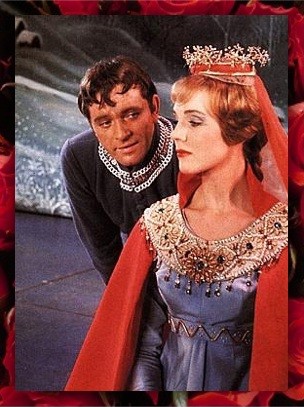
Those lyrics say a lot about the "Legend of King Arthur" and the many literary works that have been written. As well as plays, operas, television mini-series, animated features and motion pictures. This article is limited to some of the written works and a selected group of motion pictures that reflect the different ways the "Legend" was told. To cover everything about "King Arthur", as of this writing, would be a very thick book in deed.
Was there a real King Arthur and Queen Guinevere?
The "Arthurian Legend" has been a popular subject and pertaining to this blog's motion picture motivation. As of this writing the last film adaption, "King Arthur: Legend of the Sword", was released May 12, 2017 and promptly died at the Box Office, but the fact remains it was made.
According to to the "Legend" "Arthur and His Knights" defended Britain against the Saxons in the late 5th Century to the early 6th Century. The first mention of both "Arthur" and "Guinevere" is in a pseudo-historical account entitled "Historia regum Britanniae (The History of the Kings of Britain)". This work was originally entitled "De gestis Britonum (On the Deeds of the Britons)" and was published around 1136 by Geoffrey of Monmouth a British cleric. The work is also the second mention of the magician called "Merelini (Merlin)".The first mention of "Merlin" was also by Monmouth. That work was the "Prophetiae Merlin (Prophecies of Merlin)" thought to be written in 1135..
The "Historia regum Britanniae" contains the first mention of "Medraut (Mordred)". According to Geoffrey of Monmouth he is not "Arthur's" illegitimate son by his half sister "Morgan", but the son of "King Lot". In "Vits Merlini (The Life of Merlin)" believed to have been written in 1150 by Geoffrey of Monmouth. The reader first meets "Arthur's" half sister "Morgan" along with the first mention of the "Isle of Avalon"
The original introduction to Geoffrey of Monmouth's 1136 work states it's based upon an:
---ancient book in the British language that told in orderly fashion the deeds of the Kings of Britain.There is one last major character found in the "Arthurian Legends" and that is "Lancelot du Lac (Lancelot of the Lake)".He is not in any of the writing of Geoffrey of Monmouth. His first appearance is in a French Poem "Lancelot, le Chevalier de la Charrett (Lancelot, the Knight of the Cart)". Written during the 12th Century by Chretien de Troyes.Who would write several epic poems about "King Arthur" which included the first mention of his Kingdom called "Camelot".
Both historians and archaeologists question the existence of a real Arthur and can not find any supporting evidence that such a King lived.
The First Filmed Arthurian Tale
To arrive at the very first motion picture to tell a variation of the "Arthurian Legend". We must look at an opera written by German Composer Richard Wagner. Best known for a four part opera "Der Ring des Nibelungen (The Ring of the Nibelung) that tells the story of "Siegfried" and "Brunhilde".
The opera we are interested in was entitled "Parzifal". Richard Wagner's opera premiered July 26, 1882 and was based upon "Parzival (Parsival)". An epic poem written by an actual 13th Century German Knight and Poet Wolfram von Eschenbach. The date of the publishing of the poem is unknown, but it tells of "Parsival's" search for the "Holy Grail". In von Eschenbach's poem the grail is actually a gem stone.
In 1903 Wagner's widow unsuccessfully attempted to stop a performance of her husband's opera by the New York Metropolitan Opera Company. Her action caused a scandal that movie producer Harley Merry used to both acquire the motion picture rights to Richard Wagner's opera and publicize his short 1904 film starring actor Robert Whittier. There are no photos available, but we do have this advertisement from the "Edison Company" for the film:
Klingsor seeks admission to the Holy Grail. Evil summons Kundry. Herzeloid appears with the child Parsifal. Crowning of Amfortas. Wounding of Amfortas. Carrying Amfortas to his bath. Kundry brings relief to Amfortas. Parsifal reproached for killing the Swan. Kundry succumbs to Evil. Knights entering the Holy Grail. Parsifal unmoved. Klingsor summons Kundry. Parsifal enters the Magic Garden. Kundry kisses Parsifal. Parsifal calls upon the Saviour. Parsifal repulses Kundry. Klingsor hurls the Sacred Spear. Destruction of the Magic Garden. Guernemanz restores Kundry. Parsifal appears with Sacred Spear. Kundry washes Parsifal's feet. Amfortas tears open his wound. Parsifal heals Amfortas. Parsifal becomes King of the Holy Grail.
The First Appearance of Arthur and Guinevere On the Movie Screen
In 1908 the motion picture was "Lancelot and Elaine". Not only is this the first motion picture about "King Arthur" and "Queen Guinevere", but the first to have moved the period of those early tales from the 6th Century to the 12th Century. The time of the rein of "Richard, Coeur de Loin".
The known cast is listed as only five actors with Charles Kent portraying :King Arthur", "Florence Turner" as "Elaine" and Paul Panzer as "Lancelot".
The motion picture revolves around another character in "Arthurian Legend". She was "Elaine of Astolat", or also called "Elyane of Ascolot". "Elaine" first appears in Sir Thomas Malory's "Le Morte Darthur (The Death of Arthur)" more commonly known as "Le Morte d'Arthur". It was first published in 1485 and is one of the most read works on "King Arthur and his Knights" and contains many different tales about individual Knights.
There is mention of "Queen Guinevere" in the film at being in both the opening and closing sequences, but I could not locate who portrayed her if at all. The known cast of five are the three I've mentioned and two other men whose roles are not mentioned.
The short film tells of a tournament held by "King Arthur" and out of "Lancelot's" love for the Queen". How he rides out of "Camelot" to get away from the situation and meets "Elaine". Who, per Sir Thomas Malory, falls in love with "Lancelot", but can never have him and dies of a broken heart.
A Connecticut Yankee in King Arthur's Court
In 1889 the humorist Samuel Langhorne Cleamens as "Mark Twain" wrote "A Connecticut Yankee in King Arthur's Court". The novel was originally titled "A Yankee in King Arthur's Court" and alternately "A Yankee At the Court of King Arthur".
The story opens at Warwick Castle, in present day England, as an narrator relates the tale of American "Henry Morgan". In this narrative 19th Century "Henry Morgan" is transported to the 6th Century court of "King Arthur", in 528, from a blow on the head causing him to dream. The events are comic in nature, but the overall tone of the story is serious and Samuel Clemens uses direct quotations from Sir Thomas Malory.
"Hank" is captured by "Sir Kay" and taken to "Arthur's" court. Where he is initially ridiculed, because of the look of his clothing and his speech. He next finds himself sentenced to burn at the stake on June 21, 528. Which, as "Hank" knows, is the date of a historical solar eclipse. This enables him to prevent his death, but makes an enemy out of "Merlin".
"Hank Morgan" becomes the principle minister for "King Arthur". Through his modern ideas "Hank" starts to improve the life of the people and is given the title of "Sir Boss". These actions and his popularity with the court now adds "Morgan le Fey" and her son "Mordred" to his enemies list. At one point he falls in love with a young women named "Deimoselle Allsande a la Carteloise" that "Hank" nicknames "Sandy".
In the end "Hank Morgan" cannot prevent the murder of "King Arthur". Three years after the murder he is married to"Sandy" and they have a baby. However, "Hank" now has three enemies: "Merlin", "Morgan le Fay" and the Catholic Church. That is fearful of "Hank's" power causing people not to follow it. Which reflects the views of Samuel Clemens to certain policies of the church in the 1880's.
"Merlin" casts a spell on "Hank" sending him back to his own time. The narrator has actually been at "Hank Morgan's" death bed as the "Connecticut Yankee" dreams of "Sandy" and dies.
The first motion picture of the novel was a silent released March 14, 1921. It starred Harry Myers as "Hank Morgan", Pauline Starke played "Sandy" and Rosemary Theby was the renamed "Queen Morgan le Fey" There is no "Guinevere", but Charles Clary was "King Arthur". William V. Mong was "Merlin the Magician".
The movie was a hit and within its screenplay the viewer found mention of the following: The World War One "Battle of the Argonne Forest, the "Volstead Act (Prohibition)" and the Ford Model "T" cars. The one seen below was made by "Hank Morgan" in "King Arthur's" court.

According to some authors the 1921 movie contained a hanging scene. That inspired Katherine Hepburn's brother Tom to commit suicide when she was a young girl.
On April 6, 1931 the Fox Corporation released their remake of the 1921 movie in sound starring Will Rodgers.

Here we have a humorist in Will Rodgers:
I Only Know What I Read in the Papersappearing in a classic novel by another humorist Mark Twain commenting on modern times.
The story starts in the modern world as Radio parts salesman "Hank Martin" goes to an old spooky mansion during a Thunderstorm. There he meets a young girl, played by Maureen O'Sullivan, who begs him to help her get away. There is a young man hiding in a suit of armor, Frank Albertson, and another women, Myrna Loy, who tells "Hank" not to help the girl. Next he meets an Inventor and the owner of the Mansion, William Farnum. He made an invention that lets a person hear sounds from the past. As "Hank" helps hook up a battery to it the storm rages on. Suddenly there's a bolt of lightening hitting the battery. "Hank Martin" is knocked out and wakes up in the court of "King Arthur". Where everyone he has met is now part of the court.

Above the modern world of "Hank Martin" and the Inventor played by William Fanum/ Below Myrna Loy as "Morgan le Fey".


Above Frank Albertson as "Emile le Poulet" and Will Rodgers. Below Maureen O'Sullivan in the movies opening sequence.

The most known version of the Mark Twain novel premiered in New York City on April 7, 1949 and was a musical comedy.
.
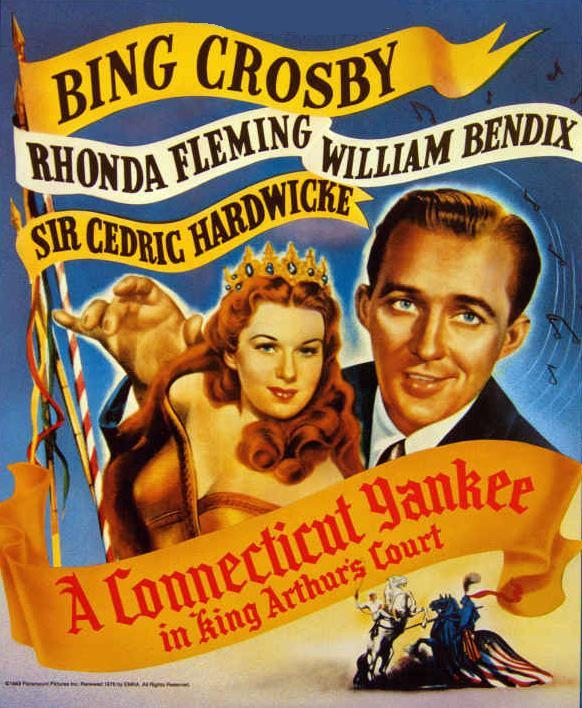
The role of "Hank Martin" was played by Bing Crosby, Rhonda Fleming was "Alisande la Carteloise", William Bendix was "Sir Sagramore" and Sir Cedric Hardwicke was both "Lord Pendragon" and "King Arthur".
The story has "Hank Martin" going to England and finding a specific castle owned by "Lord Pendragon". He begins the tour with other visitors of the castle. He sees a painting of a girl and this leads to "Hank" relatin g his story in flashback to "Lord Pendragon".
"Hank" tells of the friendship of "Sir Sagramore" and "King Arthur". His love for "Alisande" he nicknames "Sandy" and the treachery of "Merlin", played by Murvyn Ve, and "Morgan le Fey", portrayed by Virginia Field.
After the story is finished and "Hank" and "Pendragon" are sitting in the castle. The friendly Lord suggests "Hank" go out a door not on the tour and in the garden is the modern day "Sandy".

Above Bing Crosby and Sir Cedric Hardwicke as "King Arthur".Below Crosby and William Bendix as "Sir Sagramore".

Above Crosby and Rhonda Fleming as "Sandy". Below, Rhonda Flemiing as "Alisande la Carteloise", Sir Cedric Hardwicke as "King Arthur, and to his right are Virginia Field as "Morgan le Fey" and Murvyn Ve as "Merlin".
A Hollywood Cliff Hanger Serial and a British Television Series
"The Adventures of Sir Galahad" was a 15 Chapter Serial from Columbia Pictures. The first Chapter premiered on December 22, 1949. This was one of the productions from Sam Katzman. Who had already brought to the motion picture screen DC"s "Superman" in 1948 and later in 1949 the serial "Batman and Robin". He would also produce Ray Harryhausen's 1955 "It Came from Beneath the Sea" and 1956's "Earth vs the Flying Saucers".
My article on Sam Katzman and the many "B" movies he produced including with Elvis. Can be read at:
http://www.bewaretheblog.com/2018/10/superman-meets-giant-claw-as-earth-vs.html
Portraying "Sir Galahad" was pre-televisions "The Adventures of Superman" George Reeves.

The story follows "Sir Lancelot's" son :"Galahad". He wants to be a Knight of the Round Table and must find out who has stolen "Excalibur". The 15 Chapters introduce viewers to many of the main characters of the "Arthurian Legend".
The serial is considered one of the best ever made and was written by George H. Plympton. Who wrote many serials going back to 1936's "Flash Gordon" starring Buster Crabbe. His others included 1939's "The Phantom Creeps" starring Bela Lugosi, 1940's "The Green Hornet", 1942's "Captain Midnight", the already mentioned 1948 "Superman" and 1949's "Batman and Robin". Along with 1950's "Atom Man vs Superman" that conrtained the first screen appearance of "Lex Luther".

Above Lois Hall as "The Lady of the Lake" and George Reeves as "Galahad". Below William Fawcett as "Merlin and Pat Barton as "Morgan le Fey".

In 1956 the first of two seasons of a British television series, also seen in the United States, was released. The title was "The Adventures of Sir Lancelot".

Above left to right: Ronald Leigh-Hunt as "King Arthur", Cyril Smith as "Merlin", Jane Hylton as "Guinevere" and William Russell as"Sir Lancelot".
American Politics and British Tax Laws
The first half of the 1950's had a large amount of "King Arthur" and "Richard the Lion Hearted" based motion pictures coming out of Hollywood. Two major events were occurring causing these productions to be made.
One was the political aspect caused by the "Communist Witch Hunts" originated by Senator Joseph McCarthy and being carried out by the "House Committee On Un-American Activities".Both leading to the "Hollywood Black Listings" of producers, directors, writers and actors. Hollywood started to make so called "Safe Movies" to avoid Congress. 1950's Audiences started to see a large number of Pirate movies, Westerns, films about British Knights and their lades made in the U.K. and definitely safe Biblical epics.
The second reason for making many motion pictures in the U.K. Resulted from American studios depositing funds in British banks prior to the start of World War 2. During the war the money couldn't be touched and was compounding interest and growing. When the war ended and the American studios wanted to get at those funds. They discovered that they would have to pay U.K. Income Tax and a double Income Tax from the United States on the money being brought into the country. However, there was a way around both countries Tax Laws, if the American studios used their funds to make movies in the U.K/with mostly British crews. The British Taxes would be waived and there were no import tax on a finished motion picture the United States could Tax the Box Office receipts.
"Knights of the Round Table" was released on December 22, 1953 and was the first motion picture from Metro-Goldwyn-Mayer in CinemaScope. Remember this was the main year for 3-D movies. So note the tag line about CinemaScope.

Robert Taylor was "Lancelot", Ava Gardner was "Guinevere and Mel Ferrer was "Arthur". The movie is considered one of the best of the period..

Above Mel Ferrer as "Arthur" weds Ava Garner as "Guinevere". Below Mel Ferrer with Robert Taylor as "Lancelot".


Age may seem a little off with. Stanley Baker as "Mordred" and Anne Crawford as his mother "Morgan le Fey". Below Felix Aylmer as "Merlin".

Below Robert Taylor and Maureen Swanson as "Elaine".

The movie tackles, in grand overblown Hollywood style, the entire legend. There is "Arthur" pulling the sword from the stone, the arrival of "Lancelot", his love for "Guinevere" and, as above, her marriage to "King Arthur". The tragic story of "Elaine's" love for "Lancelot", the betrayal of the King by the Queen and her lover and the banishment of "Guinevere" to a convent.
All overshadowed by the intrigue of "Mordred" and his mother. That creates a civil war bringing down "Camelot" and leading to the deaths of both "Arthur" and "Modred". Then at the end, when all seems dark, the vision of "Percival" of the "Holy Grail" and a prediction that "Lancelot's" son 'Galahad" will become a gallant Knight and "Lancelot" will be forgiven of his sins.
All of this done in one hour and fifty-five minutes. The films budget was 2.6 million 1953 dollars and the worldwide box office was 8.1 million 1953 dollars.
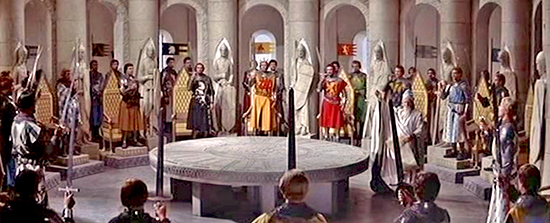


There were two other very popular motion pictures set within "Camelot". That unlike Robert Taylor who was seen in "Ivanhoe" and "Quo Vadis". Starred two very unusual actors for their roles.
The first was released April 5, 1954 and was based upon a popular comic strip by Hall Foster started in 1937 and still running in 1954. The motion picture was "Prince Valiant" and starred Robert Wagner wearing a pre-Beatles Wig..

The villain was James Mason as "The Black Knight".

The second feature was called "The Black Knight" and starred Alan Ladd. He's a lowly blacksmith that becomes the title character in a suit of armor he made. In this case the title character is the unknown protector of "Camelot". The picture was released August 25, 1954.
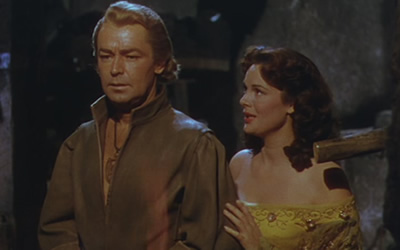
One of the villains "Sir Palamides" was portrayed by basically unknown Peter Cushing.
"The Adventures of Sir Galahad" was a 15 Chapter Serial from Columbia Pictures. The first Chapter premiered on December 22, 1949. This was one of the productions from Sam Katzman. Who had already brought to the motion picture screen DC"s "Superman" in 1948 and later in 1949 the serial "Batman and Robin". He would also produce Ray Harryhausen's 1955 "It Came from Beneath the Sea" and 1956's "Earth vs the Flying Saucers".
My article on Sam Katzman and the many "B" movies he produced including with Elvis. Can be read at:
http://www.bewaretheblog.com/2018/10/superman-meets-giant-claw-as-earth-vs.html
Portraying "Sir Galahad" was pre-televisions "The Adventures of Superman" George Reeves.

The story follows "Sir Lancelot's" son :"Galahad". He wants to be a Knight of the Round Table and must find out who has stolen "Excalibur". The 15 Chapters introduce viewers to many of the main characters of the "Arthurian Legend".
The serial is considered one of the best ever made and was written by George H. Plympton. Who wrote many serials going back to 1936's "Flash Gordon" starring Buster Crabbe. His others included 1939's "The Phantom Creeps" starring Bela Lugosi, 1940's "The Green Hornet", 1942's "Captain Midnight", the already mentioned 1948 "Superman" and 1949's "Batman and Robin". Along with 1950's "Atom Man vs Superman" that conrtained the first screen appearance of "Lex Luther".

Above Lois Hall as "The Lady of the Lake" and George Reeves as "Galahad". Below William Fawcett as "Merlin and Pat Barton as "Morgan le Fey".

In 1956 the first of two seasons of a British television series, also seen in the United States, was released. The title was "The Adventures of Sir Lancelot".

Above left to right: Ronald Leigh-Hunt as "King Arthur", Cyril Smith as "Merlin", Jane Hylton as "Guinevere" and William Russell as"Sir Lancelot".
American Politics and British Tax Laws
The first half of the 1950's had a large amount of "King Arthur" and "Richard the Lion Hearted" based motion pictures coming out of Hollywood. Two major events were occurring causing these productions to be made.
One was the political aspect caused by the "Communist Witch Hunts" originated by Senator Joseph McCarthy and being carried out by the "House Committee On Un-American Activities".Both leading to the "Hollywood Black Listings" of producers, directors, writers and actors. Hollywood started to make so called "Safe Movies" to avoid Congress. 1950's Audiences started to see a large number of Pirate movies, Westerns, films about British Knights and their lades made in the U.K. and definitely safe Biblical epics.
The second reason for making many motion pictures in the U.K. Resulted from American studios depositing funds in British banks prior to the start of World War 2. During the war the money couldn't be touched and was compounding interest and growing. When the war ended and the American studios wanted to get at those funds. They discovered that they would have to pay U.K. Income Tax and a double Income Tax from the United States on the money being brought into the country. However, there was a way around both countries Tax Laws, if the American studios used their funds to make movies in the U.K/with mostly British crews. The British Taxes would be waived and there were no import tax on a finished motion picture the United States could Tax the Box Office receipts.
"Knights of the Round Table" was released on December 22, 1953 and was the first motion picture from Metro-Goldwyn-Mayer in CinemaScope. Remember this was the main year for 3-D movies. So note the tag line about CinemaScope.

Robert Taylor was "Lancelot", Ava Gardner was "Guinevere and Mel Ferrer was "Arthur". The movie is considered one of the best of the period..
Above Mel Ferrer as "Arthur" weds Ava Garner as "Guinevere". Below Mel Ferrer with Robert Taylor as "Lancelot".


Age may seem a little off with. Stanley Baker as "Mordred" and Anne Crawford as his mother "Morgan le Fey". Below Felix Aylmer as "Merlin".

Below Robert Taylor and Maureen Swanson as "Elaine".

The movie tackles, in grand overblown Hollywood style, the entire legend. There is "Arthur" pulling the sword from the stone, the arrival of "Lancelot", his love for "Guinevere" and, as above, her marriage to "King Arthur". The tragic story of "Elaine's" love for "Lancelot", the betrayal of the King by the Queen and her lover and the banishment of "Guinevere" to a convent.
All overshadowed by the intrigue of "Mordred" and his mother. That creates a civil war bringing down "Camelot" and leading to the deaths of both "Arthur" and "Modred". Then at the end, when all seems dark, the vision of "Percival" of the "Holy Grail" and a prediction that "Lancelot's" son 'Galahad" will become a gallant Knight and "Lancelot" will be forgiven of his sins.
All of this done in one hour and fifty-five minutes. The films budget was 2.6 million 1953 dollars and the worldwide box office was 8.1 million 1953 dollars.



There were two other very popular motion pictures set within "Camelot". That unlike Robert Taylor who was seen in "Ivanhoe" and "Quo Vadis". Starred two very unusual actors for their roles.
The first was released April 5, 1954 and was based upon a popular comic strip by Hall Foster started in 1937 and still running in 1954. The motion picture was "Prince Valiant" and starred Robert Wagner wearing a pre-Beatles Wig..

The villain was James Mason as "The Black Knight".

The second feature was called "The Black Knight" and starred Alan Ladd. He's a lowly blacksmith that becomes the title character in a suit of armor he made. In this case the title character is the unknown protector of "Camelot". The picture was released August 25, 1954.

One of the villains "Sir Palamides" was portrayed by basically unknown Peter Cushing.
My article on both these motion pictures and a third set during the reign of the real Henry IV of England starring Tony Curtis and Janet Leigh. May be read at:
http://www.bewaretheblog.com/2016/05/yonder-lies-castle-of-my-fodder-tony.html
The Ounce and Future King
A favorite of mine is "The Ounce and Future King" written by Terence Hanbury "Tim" White better known as T.H. White. The novel was published in 1958 and is divided into two sections. The first tells the story of the birth of "Arthur" known to "Merlin" as "Wart", The second part tells of the adult "Arthur". The entire novel is based upon Sir Thomas Mallory's "Le Morte d'Arthur".
On December 3, 1960 from the team who created "My Fair Lady", Alan Jay Lerner, whose lyrics opened this article, and Frederick Loewe, their new Broadway musical "Camelot" opened The original cast starred Richard Burton as "King Arthur" and Julie Andrews as "Guinevere".

Robert Goulet was "Lancelot".
http://www.bewaretheblog.com/2016/05/yonder-lies-castle-of-my-fodder-tony.html
The Ounce and Future King
A favorite of mine is "The Ounce and Future King" written by Terence Hanbury "Tim" White better known as T.H. White. The novel was published in 1958 and is divided into two sections. The first tells the story of the birth of "Arthur" known to "Merlin" as "Wart", The second part tells of the adult "Arthur". The entire novel is based upon Sir Thomas Mallory's "Le Morte d'Arthur".
On December 3, 1960 from the team who created "My Fair Lady", Alan Jay Lerner, whose lyrics opened this article, and Frederick Loewe, their new Broadway musical "Camelot" opened The original cast starred Richard Burton as "King Arthur" and Julie Andrews as "Guinevere".

Robert Goulet was "Lancelot".
Playing "Mordred" was Rodney McDowell.

On December 25, 1963 Walt Disney released an animated motion picture extremely faithful to the first section of T.H. White's novel . The film took its name from the title of that section "The Sword in the Stone". As with the novel the animated film tells of "Merlin's" tutelage of the young boy who will become "King Arthur". The story leads up to "Wart" pulling "Escalibur" from "The Sword in the Stone" and being recognized as "King Arthur".

On December 25, 1963 Walt Disney released an animated motion picture extremely faithful to the first section of T.H. White's novel . The film took its name from the title of that section "The Sword in the Stone". As with the novel the animated film tells of "Merlin's" tutelage of the young boy who will become "King Arthur". The story leads up to "Wart" pulling "Escalibur" from "The Sword in the Stone" and being recognized as "King Arthur".
On October 25, 1967 the Lerner and Loewe musical "Camelot" came to the motion picture screen.
The role of "King Arthur" was portrayed by Richard Harris. "Guinevere" was portrayed by Vanessa Redgrave, "Lancelot" by Franco Nero and "Mordred" by David Hemmings.

Above left to right are Franco Nero whose singing voice was dubbed, Richard Harris and Vanessa Redgrave and below David Hemmings who songs were just removed from the score.

The story opens with "King Arthur" scared and worried over his upcoming marriage to "Guinevere". Richard Harris sings "I Wonder What the King is Doing Tonight?" His meeting with her and the upbeat version of the song "Camelot". All leading to the happiness of "Camelot" and the arrival of "Lancelot du Luc".
Then the story shifts to the romance between "Lancelot" and "Guinevere" and the manipulation of the two and "Arthur" by "Mordred. All resulting in the fall of "Camelot" and "King Arthur". The movie ends with Richard Harris singing the reprise of "Camelot" with the lyrics this article opened with.




Two Different British Versions of the Arthurian Legend from 1963
On June 2, 1963 in the U.K. "Lancelot and Guinevere" was released. The motion picture would be called "The Sword of Lancelot" in the United States.

The movie was co-produced, co-written and directed by its star Cornel Wilde who portrayed "Lancelot". The role of "Queen Guinevere" was portrayed by Wilde's then wife actress Jean Wallace and Brian Aherne was "King Arthur". The movie is very good and is basically the love story between "Lancelot" and "Guinevere".

Above the castle of "Camelot". Below left to right are Mark Dignam as "Merlin", Brian Aherne as "King Arthur" and Cornel Wilde as "Lancelot".

To be able to marry "Guinevere". 'King Arthur's"champion must defeat her father's champion in a joust. . After the joust and on the way back to "Camelot". "Guinevere" falls in love with "King Arthur's" champion "Lancelot" and he with her. However, his honor to "Arthur" stops him from just going off with "Guinevere: as she has suggested.

Above Jean Wallace as "Guinevere" being escorted by "Lancelot". Below "Guinevere" is presented to "Arthur".


Later the spy's of "Mordred", Michael Meacham, have discovered the Queen and the King's champion making love and he uses it to first charge "Guinevere" with Witchcraft. She is sentenced to be burned at the stake, but to "Arthur's" relief "Lancelot" saves her for the time being.



However, "Mordred" continues to sow unrest that will lead to civil war against the King. "Lancelot" and some loyal men have left "Camelot" in the hope that "Arthur" and "Guinevere" will now be safe from scandal. However, that is not to be.
Below years later "Lancelot" at the head of his men returns to "Camelot" to defeat "Mordred". Who finally killed "King Arthur" and assumed the throne. "Lancelot" will kill "Mordred", but "Camelot" will never be the same.


As with all the stories "Guinevere", becomes a Nun and "Lancelot" is left alone to find his final fate..

There are three aspects to the following motion picture that just have to do with its production. The first is the executive producer was Charles H. Schneer. The second was the director was Nathan H. Juran and the third the motion picture was released by Columbia Pictures.
In 1957 these three had made Ray Harryhausen's "20 Million Years to Earth". In 1958 they made Ray Harryhsuasen's "The 7th Voyage of Sinbad" and in 1964 would make Ray Harryhausen's "First Men in the Moon". Now they were tackling a questionable "Arthurian Legend" picture.
Charles H. Schneer was Ray Harryhausen's partner going back to 1955's "It Came from Beneath the Sea". His story can be read at:
http://www.bewaretheblog.com/2016/09/charles-h-schneer-look-at-work-of.html
My article on Nathan H. Juran. Who also made in 1957 both "The Deadly Mantis" and "The Brain from Planet Arous". Along with 1958's original "Attack of the 50 Foot Women" can be read at:
http://www.bewaretheblog.com/2017/05/nathan-h-juran-look-at-work-of-man-who.html
This movie was "Siege of the Saxons" released in the U.K. in July 1963 and the United States in August 1963.
Although the screenplay finally had "Arthur's" foe as the Saxons. It did not have either "Queen Guinevere", or "Sir Lancelot". In fact the main character was "King Arthur's" daughter. Who of course had never appeared anywhere before this screenplay and the Saxon's were more like those in Sir Walter Scott's novel "Ivanhoe", set in the 12th Century, then the invaders of Britain..

The role of "King Arthur" was portrayed by Mark Dignam above on the left. He was "Merlin" in the Cornel Wilde picture.. On the right is Ronald Howard as the Saxon villain "Edmund of Cornwall". There is not "Mordred", or "Morgan le Fey" to cause trouble in "Camelot". Nine years previously Howard was the star of the 1954 television series "Sherlock Holmes".
The role of "Arthur's" daughter "Katherine" was portrayed by Janette Scott. Who in a previous year movie, according to Richard O'Brien lyrics for "Science Fiction Double Feature" from "The Rocky Horror Picture Show", had him thrilled:

Above Janette Scott as "Katherine" and John Laurie as "Merlin". Below to her immediate left is Ronald Lewis as "Robert Marshall" a "Robin Hood" rip off and to Scott's right Ronald Howard. Whose men will kill "King Arthur" and falsely tell him "Katherine" as well.

Later "Katherine", "Robert" and his "Merry Men" will rescue "Merlin" from "Edmund".
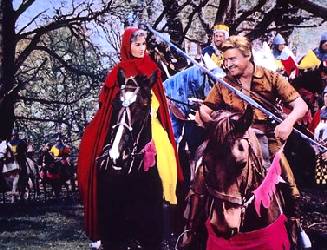

This sets up a revision of "The Sword in the Stone" story. When the dead "Katherine", the traitor "Robert" and the imprisoned "Merlin" arrive at "Camelot" as "Edmund" is about to be crowned King. "Merlin" has "Robert" challenge "Edmund" to do just pull "Excalibur" from its scabbard as proof he should be King. "Edmund" of course cannot do it and "Robert" easily pulls it out and presents it to "Katherine". Who immediately is recognized as the new Queen of England. Why "Robert" who actually pulled "Excalibur:" out is not crowned King is never explained.
This leads to the movies title as "Edmund's" Saxon's arrive and lay siege to "Camelot" setting the castle on fire. "Katherine" of course defeats them and "Edmund".
On April 10, 1981 a film based mainly on Sir Thomas Mallory's "Morte d'Arthur" was released. John Boorman, who produced, co-wrote and directed the picture.Also used the writings of Geoffrey of Monouth and Chretain de Troyes in certain segments. The original director's cut ran three hours, but when "Excalibur" was theatrically released the running time was two hours and twenty minutes. Although at times this beautifully filmed motion picture seemed to be that original three hour length.
As to the overall production. The fact that the male characters in the film wear full body armor places the story in at least the late 11th Century rather than the 6th Century.

Nigel Terry portrayed "King Arthur".

Cheri Lungri was "Queen Guinevere"

Nicolas Clay was "Lancelot".

Nicol Williamson was a scene stealing "Merlin".

A beautiful Helen Mirren was "Morgan le Fey".

Among the supporting cast were:
Robert Addie as the adult "Mordred"

Patrick Stewart portrayed "King Leodegrance" the father of "Guinevere".
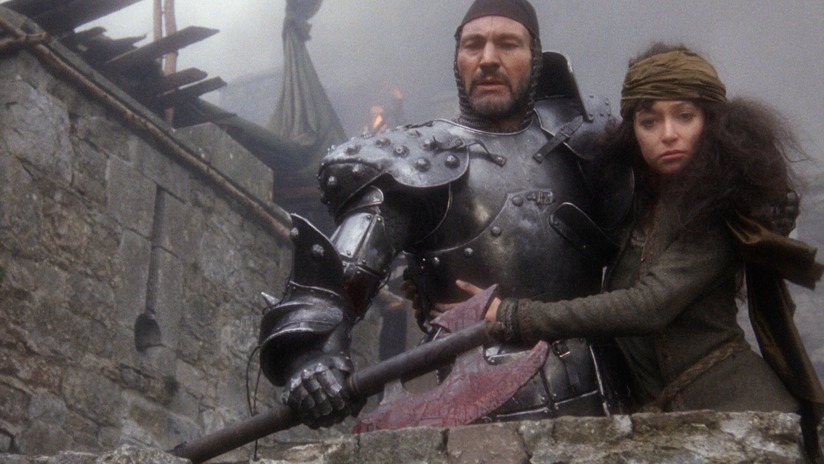
Liam Neeson was "Sir Gwain"

Gabriel Byrne portrayed "King Uther Pendragon" the father of "Arthur".

The screenplay covers a lot of ground and starts with the manipulative "Merlin" getting "Excalibur" from the "Lady of the Lake" for "King Uther Pendragon".

Before he will present him with the legendary sword. "Merlin", who seems to know the future, gets "Pendragon" to agree that the baby born between him and the wife of the "Duke of Cornwall" will be "Merlin's" to raise. The baby is named "Arthur" and after the death of "Uther" "Merlin" places "Excalibur" in the stone and it becomes known that whomever pulls it out is the rightful "King of Britain". Many will try and many will fail.
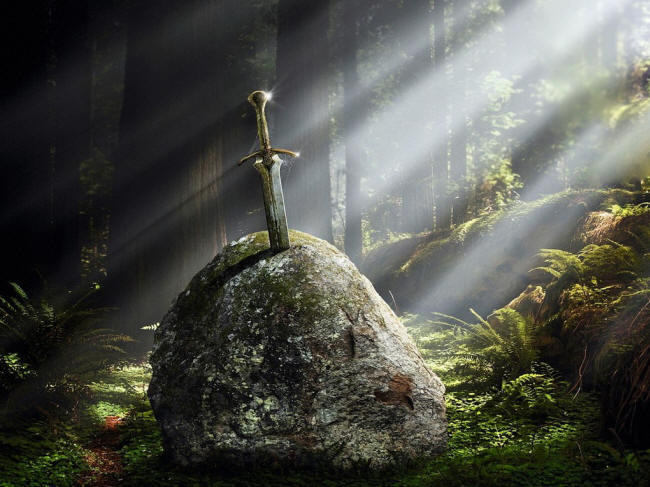

Above "Merlin" and the young "Arthur". Nigel Terry was 35 at the time, but portrayed "Arthur" from his youth, under the tutelage of "Merlin", until the film's end. As the dying King is carried to the island of "Avalon" and "Percival", at "Arthur's" orders, throws "Excalibur" back to the "Lady of the Lake"./.

After pulling out the sword "King Leodegrance" is the first to recognize "Arthur" as King of all Britain. While some will not recognize the boy as their King and the Knights divide themselves into two camps. A war between the new King's supporters and those who do not recognize him breaks out. Until "Arthur" does something "Merlin" never foresaw. "Arthur" realizes he is not a Knight and as such can not rule. So instead of killing Keith Buckley, below, as "Uryens". "Arthur" gives him "Excalibur" and asks that "Uryens" dub him a Knight.

Below the marriage of the "Arthur" to "Guinevere".

The screenplay centers more around "Merlin" rather than "Arthur" and his constant duel with "Arthur's" half sister "Morgan le Fey".


The story brings the viewer to the arrival of "Lancelot". That starts with a dual between "Lancelot" and "King Arthur", whom he does not recognize, over the Frenchman's view that he is the greatest swordsman in the world and "Arthur's" protector..

Over a short period of time "Lancelot" is given the role of protector of "Guinevere" and this will lead to their romance.
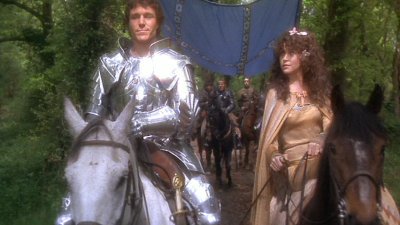

The screenplay goes into detail concerning the plotting of "Morgan le Fey". From raising her son and "Arthur's" she has named "Mordred". To her scheme to take the throne away and give it to "Mordred". This subplot is built up slowly from "Mordred's" birth to adulthood. Just as the love between "Guinevere" and "Lancelot" is not the over night affair of all the previous film versions of the "Arthurian Legend".

When that climatic confrontation between "Mordred" and "King Arthur" occurs. The picture has covered many years and "Arthur" has grey in his beard and hair.


"Excalibur" has a great middle age look that helps its story, but as I said. Boorman still gets the period of "Morte d'Arthur" wrong by about 600 years because of the armor.
Known for the television series "CSI" and it many spin-offs. Along with "The Pirates of the Caribbean" motion picture franchise. Producer Jerry Bruckheimer on July 7, 2004 brought the viewing audience "King Arthur".
The screenplay was by David Franzoni. Among Franzoni's six screenplays was the 2000 feature "Gladiator" that he also co-produced with director Ridley Scott. That previous production should have sent a warning signal to producer Bruckheimer about the screenplay and story Franzoni came up with for "King Arthur".
In 1964 producer Samuel Bronston released "The Fall of the Roman Empire". The all star cast was headed by Sophia Loren. Stephen Boyd, Alec Guinness, James Mason and Christopher Plummer. Franzoni probably thought after 36 years people would have forgotten the 1964 motion picture, He overlooked the critics, actual Roman historians and movie buffs.
His 2000 "Gladiator" wasn't a complete steal. However, his screenplay had several major scenes from the other motion picture with not only the exact dialogue, but the exact camera cues and shot angles. His claim was he had never seen "The Fall of the Roman Empire" which was the exact subject matter as "Gladiator" with a change to the Stephen Boyd character.
My article on Samuel Bronston and his films, pre-CGI, with giant sets and casts of thousands of real people. May be read at:
http://www.bewaretheblog.com/2016/04/samuel-bronston-movies-featuring-cast.html
David Franzoni's screenplay for "King Arthur", released in 2004, places the story in 401 A.D. during the closing of the Roman occupation of Britain. As I will mention he made many major historical mistakes revolving around the year he choose. Although Bruckheirmer and Franzoni advertised their film as "Historically Accurate". So lets take a look at the final "Arthurian" film I want to mention.

While I'm on lifts from other films/ There is another lift to the above poster that actress Keira Knightley objected too. On the poster her breasts were made larger to give "Guinevere" a more sexy look.
Clive Owen was the Roman "Artorius Castus" known as "Arthur". In the screenplay his father was Roman and his mother Celtic. Some historians attempting to prove "Arthur" existed. Believe he was a Roman commander known as "Lucius Artorius Castus". However, he is believed to have lived between 180 and 350 A.D.

As I mentioned Keira Knightley was "Guinevere", In this screenplay like "Arthur's" mother "Guinevere" is Celtic and a "Woad". "Woad's" were one of the groups of people that formed a confederation known as the "Picts".
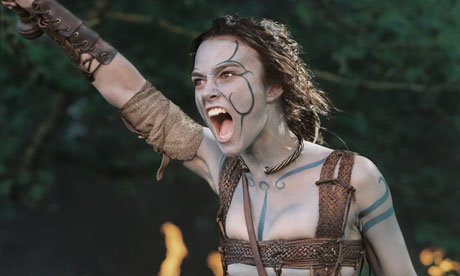
Welch actor Ioan Gruffudd is "Lancelot". There is no love story between "Guinevere" and "Lancelot". However, this "Lancelot" is a warrior, a dreamer of freedom and a realist.

The role of "King Arthur" was portrayed by Richard Harris. "Guinevere" was portrayed by Vanessa Redgrave, "Lancelot" by Franco Nero and "Mordred" by David Hemmings.

Above left to right are Franco Nero whose singing voice was dubbed, Richard Harris and Vanessa Redgrave and below David Hemmings who songs were just removed from the score.

The story opens with "King Arthur" scared and worried over his upcoming marriage to "Guinevere". Richard Harris sings "I Wonder What the King is Doing Tonight?" His meeting with her and the upbeat version of the song "Camelot". All leading to the happiness of "Camelot" and the arrival of "Lancelot du Luc".
Then the story shifts to the romance between "Lancelot" and "Guinevere" and the manipulation of the two and "Arthur" by "Mordred. All resulting in the fall of "Camelot" and "King Arthur". The movie ends with Richard Harris singing the reprise of "Camelot" with the lyrics this article opened with.




Two Different British Versions of the Arthurian Legend from 1963
On June 2, 1963 in the U.K. "Lancelot and Guinevere" was released. The motion picture would be called "The Sword of Lancelot" in the United States.

The movie was co-produced, co-written and directed by its star Cornel Wilde who portrayed "Lancelot". The role of "Queen Guinevere" was portrayed by Wilde's then wife actress Jean Wallace and Brian Aherne was "King Arthur". The movie is very good and is basically the love story between "Lancelot" and "Guinevere".

Above the castle of "Camelot". Below left to right are Mark Dignam as "Merlin", Brian Aherne as "King Arthur" and Cornel Wilde as "Lancelot".

To be able to marry "Guinevere". 'King Arthur's"champion must defeat her father's champion in a joust. . After the joust and on the way back to "Camelot". "Guinevere" falls in love with "King Arthur's" champion "Lancelot" and he with her. However, his honor to "Arthur" stops him from just going off with "Guinevere: as she has suggested.

Above Jean Wallace as "Guinevere" being escorted by "Lancelot". Below "Guinevere" is presented to "Arthur".


Later the spy's of "Mordred", Michael Meacham, have discovered the Queen and the King's champion making love and he uses it to first charge "Guinevere" with Witchcraft. She is sentenced to be burned at the stake, but to "Arthur's" relief "Lancelot" saves her for the time being.



However, "Mordred" continues to sow unrest that will lead to civil war against the King. "Lancelot" and some loyal men have left "Camelot" in the hope that "Arthur" and "Guinevere" will now be safe from scandal. However, that is not to be.
Below years later "Lancelot" at the head of his men returns to "Camelot" to defeat "Mordred". Who finally killed "King Arthur" and assumed the throne. "Lancelot" will kill "Mordred", but "Camelot" will never be the same.


As with all the stories "Guinevere", becomes a Nun and "Lancelot" is left alone to find his final fate..

There are three aspects to the following motion picture that just have to do with its production. The first is the executive producer was Charles H. Schneer. The second was the director was Nathan H. Juran and the third the motion picture was released by Columbia Pictures.
In 1957 these three had made Ray Harryhausen's "20 Million Years to Earth". In 1958 they made Ray Harryhsuasen's "The 7th Voyage of Sinbad" and in 1964 would make Ray Harryhausen's "First Men in the Moon". Now they were tackling a questionable "Arthurian Legend" picture.
Charles H. Schneer was Ray Harryhausen's partner going back to 1955's "It Came from Beneath the Sea". His story can be read at:
http://www.bewaretheblog.com/2016/09/charles-h-schneer-look-at-work-of.html
My article on Nathan H. Juran. Who also made in 1957 both "The Deadly Mantis" and "The Brain from Planet Arous". Along with 1958's original "Attack of the 50 Foot Women" can be read at:
http://www.bewaretheblog.com/2017/05/nathan-h-juran-look-at-work-of-man-who.html
This movie was "Siege of the Saxons" released in the U.K. in July 1963 and the United States in August 1963.
Although the screenplay finally had "Arthur's" foe as the Saxons. It did not have either "Queen Guinevere", or "Sir Lancelot". In fact the main character was "King Arthur's" daughter. Who of course had never appeared anywhere before this screenplay and the Saxon's were more like those in Sir Walter Scott's novel "Ivanhoe", set in the 12th Century, then the invaders of Britain..

The role of "King Arthur" was portrayed by Mark Dignam above on the left. He was "Merlin" in the Cornel Wilde picture.. On the right is Ronald Howard as the Saxon villain "Edmund of Cornwall". There is not "Mordred", or "Morgan le Fey" to cause trouble in "Camelot". Nine years previously Howard was the star of the 1954 television series "Sherlock Holmes".
The role of "Arthur's" daughter "Katherine" was portrayed by Janette Scott. Who in a previous year movie, according to Richard O'Brien lyrics for "Science Fiction Double Feature" from "The Rocky Horror Picture Show", had him thrilled:
When I saw Janette Scott fight a Triffid that spits poison and kills.

Above Janette Scott as "Katherine" and John Laurie as "Merlin". Below to her immediate left is Ronald Lewis as "Robert Marshall" a "Robin Hood" rip off and to Scott's right Ronald Howard. Whose men will kill "King Arthur" and falsely tell him "Katherine" as well.

Later "Katherine", "Robert" and his "Merry Men" will rescue "Merlin" from "Edmund".


This sets up a revision of "The Sword in the Stone" story. When the dead "Katherine", the traitor "Robert" and the imprisoned "Merlin" arrive at "Camelot" as "Edmund" is about to be crowned King. "Merlin" has "Robert" challenge "Edmund" to do just pull "Excalibur" from its scabbard as proof he should be King. "Edmund" of course cannot do it and "Robert" easily pulls it out and presents it to "Katherine". Who immediately is recognized as the new Queen of England. Why "Robert" who actually pulled "Excalibur:" out is not crowned King is never explained.
This leads to the movies title as "Edmund's" Saxon's arrive and lay siege to "Camelot" setting the castle on fire. "Katherine" of course defeats them and "Edmund".
On April 10, 1981 a film based mainly on Sir Thomas Mallory's "Morte d'Arthur" was released. John Boorman, who produced, co-wrote and directed the picture.Also used the writings of Geoffrey of Monouth and Chretain de Troyes in certain segments. The original director's cut ran three hours, but when "Excalibur" was theatrically released the running time was two hours and twenty minutes. Although at times this beautifully filmed motion picture seemed to be that original three hour length.
As to the overall production. The fact that the male characters in the film wear full body armor places the story in at least the late 11th Century rather than the 6th Century.

Nigel Terry portrayed "King Arthur".

Cheri Lungri was "Queen Guinevere"

Nicolas Clay was "Lancelot".

Nicol Williamson was a scene stealing "Merlin".

A beautiful Helen Mirren was "Morgan le Fey".

Among the supporting cast were:
Robert Addie as the adult "Mordred"

Patrick Stewart portrayed "King Leodegrance" the father of "Guinevere".

Liam Neeson was "Sir Gwain"

Gabriel Byrne portrayed "King Uther Pendragon" the father of "Arthur".

The screenplay covers a lot of ground and starts with the manipulative "Merlin" getting "Excalibur" from the "Lady of the Lake" for "King Uther Pendragon".

Before he will present him with the legendary sword. "Merlin", who seems to know the future, gets "Pendragon" to agree that the baby born between him and the wife of the "Duke of Cornwall" will be "Merlin's" to raise. The baby is named "Arthur" and after the death of "Uther" "Merlin" places "Excalibur" in the stone and it becomes known that whomever pulls it out is the rightful "King of Britain". Many will try and many will fail.


Above "Merlin" and the young "Arthur". Nigel Terry was 35 at the time, but portrayed "Arthur" from his youth, under the tutelage of "Merlin", until the film's end. As the dying King is carried to the island of "Avalon" and "Percival", at "Arthur's" orders, throws "Excalibur" back to the "Lady of the Lake"./.

After pulling out the sword "King Leodegrance" is the first to recognize "Arthur" as King of all Britain. While some will not recognize the boy as their King and the Knights divide themselves into two camps. A war between the new King's supporters and those who do not recognize him breaks out. Until "Arthur" does something "Merlin" never foresaw. "Arthur" realizes he is not a Knight and as such can not rule. So instead of killing Keith Buckley, below, as "Uryens". "Arthur" gives him "Excalibur" and asks that "Uryens" dub him a Knight.

Below the marriage of the "Arthur" to "Guinevere".

The screenplay centers more around "Merlin" rather than "Arthur" and his constant duel with "Arthur's" half sister "Morgan le Fey".


The story brings the viewer to the arrival of "Lancelot". That starts with a dual between "Lancelot" and "King Arthur", whom he does not recognize, over the Frenchman's view that he is the greatest swordsman in the world and "Arthur's" protector..

Over a short period of time "Lancelot" is given the role of protector of "Guinevere" and this will lead to their romance.


The screenplay goes into detail concerning the plotting of "Morgan le Fey". From raising her son and "Arthur's" she has named "Mordred". To her scheme to take the throne away and give it to "Mordred". This subplot is built up slowly from "Mordred's" birth to adulthood. Just as the love between "Guinevere" and "Lancelot" is not the over night affair of all the previous film versions of the "Arthurian Legend".

When that climatic confrontation between "Mordred" and "King Arthur" occurs. The picture has covered many years and "Arthur" has grey in his beard and hair.


"Excalibur" has a great middle age look that helps its story, but as I said. Boorman still gets the period of "Morte d'Arthur" wrong by about 600 years because of the armor.
Known for the television series "CSI" and it many spin-offs. Along with "The Pirates of the Caribbean" motion picture franchise. Producer Jerry Bruckheimer on July 7, 2004 brought the viewing audience "King Arthur".
The screenplay was by David Franzoni. Among Franzoni's six screenplays was the 2000 feature "Gladiator" that he also co-produced with director Ridley Scott. That previous production should have sent a warning signal to producer Bruckheimer about the screenplay and story Franzoni came up with for "King Arthur".
In 1964 producer Samuel Bronston released "The Fall of the Roman Empire". The all star cast was headed by Sophia Loren. Stephen Boyd, Alec Guinness, James Mason and Christopher Plummer. Franzoni probably thought after 36 years people would have forgotten the 1964 motion picture, He overlooked the critics, actual Roman historians and movie buffs.
His 2000 "Gladiator" wasn't a complete steal. However, his screenplay had several major scenes from the other motion picture with not only the exact dialogue, but the exact camera cues and shot angles. His claim was he had never seen "The Fall of the Roman Empire" which was the exact subject matter as "Gladiator" with a change to the Stephen Boyd character.
My article on Samuel Bronston and his films, pre-CGI, with giant sets and casts of thousands of real people. May be read at:
http://www.bewaretheblog.com/2016/04/samuel-bronston-movies-featuring-cast.html
David Franzoni's screenplay for "King Arthur", released in 2004, places the story in 401 A.D. during the closing of the Roman occupation of Britain. As I will mention he made many major historical mistakes revolving around the year he choose. Although Bruckheirmer and Franzoni advertised their film as "Historically Accurate". So lets take a look at the final "Arthurian" film I want to mention.

While I'm on lifts from other films/ There is another lift to the above poster that actress Keira Knightley objected too. On the poster her breasts were made larger to give "Guinevere" a more sexy look.
Clive Owen was the Roman "Artorius Castus" known as "Arthur". In the screenplay his father was Roman and his mother Celtic. Some historians attempting to prove "Arthur" existed. Believe he was a Roman commander known as "Lucius Artorius Castus". However, he is believed to have lived between 180 and 350 A.D.

As I mentioned Keira Knightley was "Guinevere", In this screenplay like "Arthur's" mother "Guinevere" is Celtic and a "Woad". "Woad's" were one of the groups of people that formed a confederation known as the "Picts".

Welch actor Ioan Gruffudd is "Lancelot". There is no love story between "Guinevere" and "Lancelot". However, this "Lancelot" is a warrior, a dreamer of freedom and a realist.

Stephen Dillane is "Merlin". "Merlin" is not the wizard of Sir Thomas Mallory, or the other writers. He is a spiritual leader of the Picts and more a warlord.
Stellan Skarsgard is "Cedric" the leader of the Saxons.
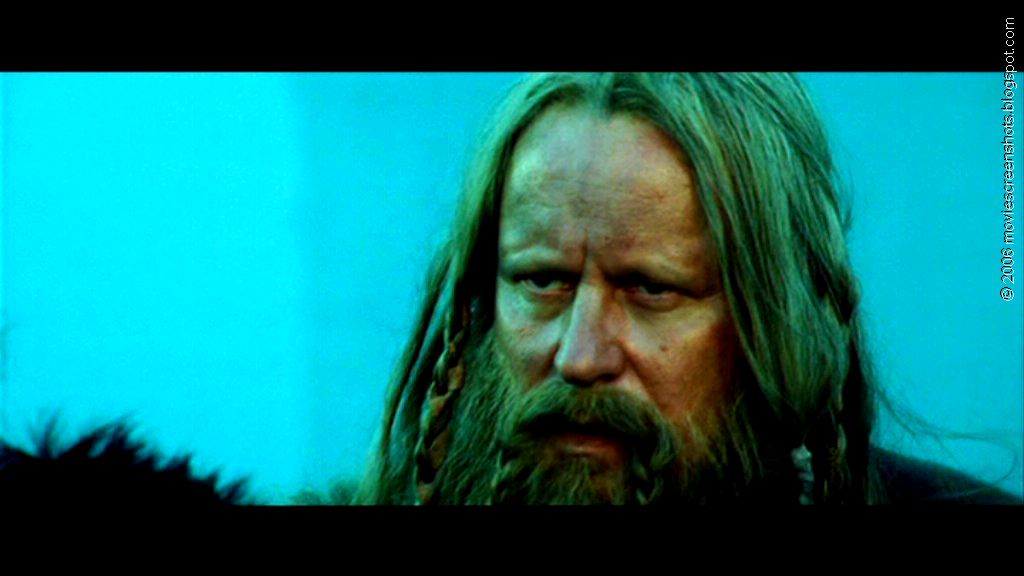
Ivano Marescotti is "Bishop Germanticus". "Germanticus" lived between 378 A.D. to 448 A.D. The historical problem here is that he didn't visit the British Isles until 429 A.D.. Which was after the Roman's had withdrawn from Britain and 19 years after the year of the screenplay.

Ivano Marescotti is "Bishop Germanticus". "Germanticus" lived between 378 A.D. to 448 A.D. The historical problem here is that he didn't visit the British Isles until 429 A.D.. Which was after the Roman's had withdrawn from Britain and 19 years after the year of the screenplay.
The screenplay speaks to a deal that was made between the warrior immigrants the Samatian's in Briton and the Roman's. For peace between them the Roman's would take some of their son's to become a Samatian auxiliary cavalry for the Roman Army. When we first meet "Lancelot" he is a young boy leaving his parents and joining a group of other young boys on horseback. They pass the property of "Arthur" and his mother, his father is dead from the wars, and asking who these young boys of his age are? His mother responds to "Artorius" the future soldiers that he might lead.

Switch 15 years later and the remainder of "Arthur's""Samatian Cavalry" are returning from their last mission. They all expect to receive their freedom papers from Rome. Besides "Lancelot", the cavalry consists of "Tristain" portrayed by Mads Mikkelsen, "Gawain" played by Joel Edgerton, "Galahad" portrayed by Hugh Dancy, "Dagonet" played by Ray Stevenson and "Bors" portrayed by Ray Winston. In "Arthurian Legend" "Dagonet" was "King Arthur's" court jester and "Bors" was actually two people a father and son.

Above Mads Mikkelsen as "Tristain" who wears oriental armor. Below on "Tristain's" left is Ray Stevenson as "Dagonet" and on the far right Ray Winston as "Bors".

They come upon a small group of Roman soldiers guarding the "Bishop Germanus of Auxerre" who carries their freedom papers. The Bishop's group is under attack by the "Woad's" at the command of "Merlin"."Arthur" and his Samatian's attack the attackers.

"Merlin's" attack group is killed except that "Arthur" saves the one man above. He is to return to "Merlin" and tell him what has happened and to stop fighting Rome. After rescuing the Bishop "Arthur" and his mean escort him to safety behind "Hadrain's Wall". Parts of the wall remain today and when it was completed. The wall was 73 miles long from the North Sea to the Irish Sea. The wall was started in 122 A.D. and was completed in 128 A.D. blocking any movement North except by sea.
Three things now take place. The first is that a large Saxon army under "Cedric" is landing.
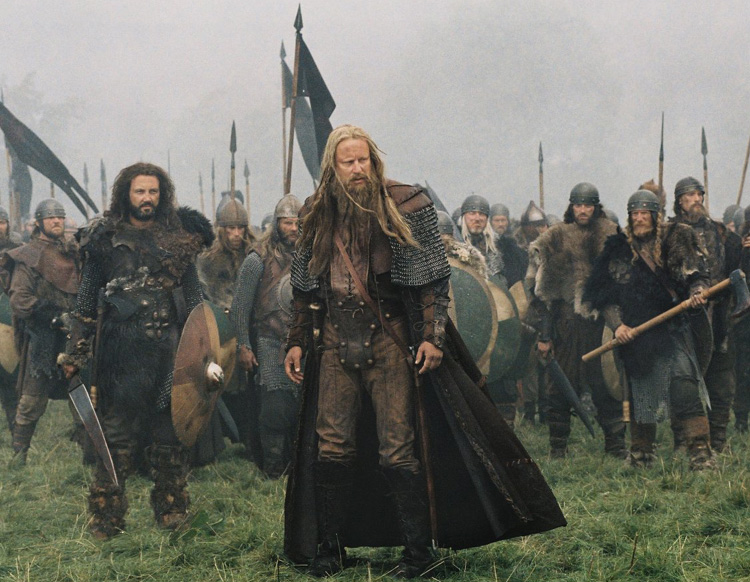
The second is that the Bishop discovers he can not sit at the head of the table to speak to "Arthur" and his men, because it is round. So that all can talk freely and there is no actual leader. The third is he will not give them the signed freedom documents until they complete one last mission. This creates dissent in "Arthur's" men, but they will follow him to rescue a young man, the fictional "Alecto", who may someday become Pope.
On their way to rescue "Alecto" and his family. The "Arthur" and his men are ambushed by the "Woad's", but a signal from "Merlin" lets them go on. They arrive at "Alecto's" parent's estate to find a small garrison of Romans, the Celts working the land treated as slaves, a sealed up dungeon run by Catholic monks and "Alecto's" father will not leave, or give them permission to take his son.
"Arthur" instructs "Dagonet" to break open the walled up entrance to the dungeon and then he enters followed by the others. There they find people being tortured, some dying and some already dead. One of these is a young women whose fingers of her bow hand has been broken. "Arthur" orders those people still alive to be taken out and treated. Next he has the monks walled up within the dungeon. He tells the Celts to go with his men as the Saxons are coming and forcibly orders "Alecto's" father and mother and their soldiers to come along. The young women is to ride within a chart and he plans to lead everyone back to "Hardian's Wall" and safety, but three things happen on the trip.
The first is that "Arthur' resets the young women's fingers and finds out she is called "Guinevere". She in turn mentions how her parents told fabulous tales of "Arthur and His Knights" that she grew up upon. The second event is that "Alecto's" father has his soldiers attempt to kill "Arthur" and his men. The father is killed and the soldiers given the choice of joining under "Arthur's" command, or being killed. They choose "Arthur". That night "Guinevere" walks through the encampment followed by "Arthur" and "Merlin" appears under a sign of truce. He reminds "Arthur" that he is half Celtic and tells him they need a strong leader to fight the Saxon's to save Britain. "Merlin" then leaves and the following morning the journey continues into the mountains as the snow starts to fall.

Switch 15 years later and the remainder of "Arthur's""Samatian Cavalry" are returning from their last mission. They all expect to receive their freedom papers from Rome. Besides "Lancelot", the cavalry consists of "Tristain" portrayed by Mads Mikkelsen, "Gawain" played by Joel Edgerton, "Galahad" portrayed by Hugh Dancy, "Dagonet" played by Ray Stevenson and "Bors" portrayed by Ray Winston. In "Arthurian Legend" "Dagonet" was "King Arthur's" court jester and "Bors" was actually two people a father and son.

Above Mads Mikkelsen as "Tristain" who wears oriental armor. Below on "Tristain's" left is Ray Stevenson as "Dagonet" and on the far right Ray Winston as "Bors".

They come upon a small group of Roman soldiers guarding the "Bishop Germanus of Auxerre" who carries their freedom papers. The Bishop's group is under attack by the "Woad's" at the command of "Merlin"."Arthur" and his Samatian's attack the attackers.
"Merlin's" attack group is killed except that "Arthur" saves the one man above. He is to return to "Merlin" and tell him what has happened and to stop fighting Rome. After rescuing the Bishop "Arthur" and his mean escort him to safety behind "Hadrain's Wall". Parts of the wall remain today and when it was completed. The wall was 73 miles long from the North Sea to the Irish Sea. The wall was started in 122 A.D. and was completed in 128 A.D. blocking any movement North except by sea.
Three things now take place. The first is that a large Saxon army under "Cedric" is landing.

The second is that the Bishop discovers he can not sit at the head of the table to speak to "Arthur" and his men, because it is round. So that all can talk freely and there is no actual leader. The third is he will not give them the signed freedom documents until they complete one last mission. This creates dissent in "Arthur's" men, but they will follow him to rescue a young man, the fictional "Alecto", who may someday become Pope.
On their way to rescue "Alecto" and his family. The "Arthur" and his men are ambushed by the "Woad's", but a signal from "Merlin" lets them go on. They arrive at "Alecto's" parent's estate to find a small garrison of Romans, the Celts working the land treated as slaves, a sealed up dungeon run by Catholic monks and "Alecto's" father will not leave, or give them permission to take his son.
"Arthur" instructs "Dagonet" to break open the walled up entrance to the dungeon and then he enters followed by the others. There they find people being tortured, some dying and some already dead. One of these is a young women whose fingers of her bow hand has been broken. "Arthur" orders those people still alive to be taken out and treated. Next he has the monks walled up within the dungeon. He tells the Celts to go with his men as the Saxons are coming and forcibly orders "Alecto's" father and mother and their soldiers to come along. The young women is to ride within a chart and he plans to lead everyone back to "Hardian's Wall" and safety, but three things happen on the trip.
The first is that "Arthur' resets the young women's fingers and finds out she is called "Guinevere". She in turn mentions how her parents told fabulous tales of "Arthur and His Knights" that she grew up upon. The second event is that "Alecto's" father has his soldiers attempt to kill "Arthur" and his men. The father is killed and the soldiers given the choice of joining under "Arthur's" command, or being killed. They choose "Arthur". That night "Guinevere" walks through the encampment followed by "Arthur" and "Merlin" appears under a sign of truce. He reminds "Arthur" that he is half Celtic and tells him they need a strong leader to fight the Saxon's to save Britain. "Merlin" then leaves and the following morning the journey continues into the mountains as the snow starts to fall.
At a frozen river the Saxton's appear under the leadership of " Cedric's" son "Cynic". Half of "Cynic's" men will fall into the frozen water after the ice breaks under their weight.
After delivering "Alecto" to the Bishop they receive their freedom papers, but during the ice battle "Dagonet" died. The Roman's are now leaving and abandoning "Hadrain's" Wall to return to Rome. "Arthur" bids farewell to his freed men and plans to stay as the words of "Merlin" have taken hold. He will be the only one left to fight against the Saxon invaders.
"Arthur's" men leave the column of retreating Roman Soldiers and towns people to join him. The Saxon's walk into a trap set by "Merlin" and "Arthur" and will be defeated at what the screenplay calls "The Battle of Baddon Hill". Historic problem again arise as the battle took place approximately 80 years after 410 A.D.. The exact year is unknown, but it is circa 500 A.D. per historians.
The film ends with the marriage of "Guinevere" to "Arthur" performed by the Pict's spiritual leader "Merlin"and proclaiming that the half Celtic-half Roman is now "King Arthur".
Will there be more motion pictures about the "Arthurian Legends"? Probably and I await them.
After delivering "Alecto" to the Bishop they receive their freedom papers, but during the ice battle "Dagonet" died. The Roman's are now leaving and abandoning "Hadrain's" Wall to return to Rome. "Arthur" bids farewell to his freed men and plans to stay as the words of "Merlin" have taken hold. He will be the only one left to fight against the Saxon invaders.
"Arthur's" men leave the column of retreating Roman Soldiers and towns people to join him. The Saxon's walk into a trap set by "Merlin" and "Arthur" and will be defeated at what the screenplay calls "The Battle of Baddon Hill". Historic problem again arise as the battle took place approximately 80 years after 410 A.D.. The exact year is unknown, but it is circa 500 A.D. per historians.
The film ends with the marriage of "Guinevere" to "Arthur" performed by the Pict's spiritual leader "Merlin"and proclaiming that the half Celtic-half Roman is now "King Arthur".
Will there be more motion pictures about the "Arthurian Legends"? Probably and I await them.






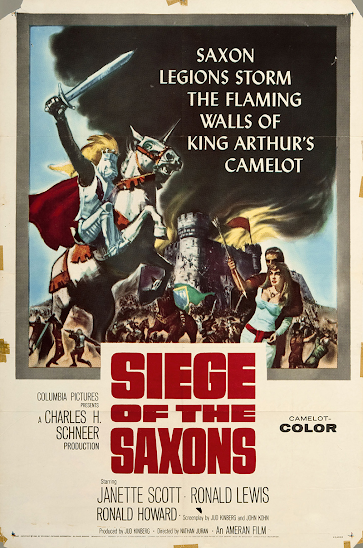







No comments:
Post a Comment